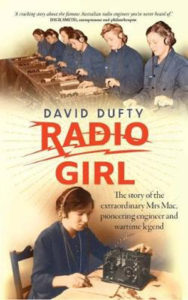- Author
- Book reviewer
- Subjects
- Biographies and personal histories, Naval Intelligence, History - WW2, Book reviews, Biographies
- Tags
-
- RAN Ships
- None noted.
- Publication
- September 2020 edition of the Naval Historical Review (all rights reserved)
Radio Girl. By David Dufty. Allen and Unwin, Sydney 2020. Paperback of 301 pages. rrp $29.99. ISBN 978 1 76087 665 4
 This biographical work details the life of Violet Mackenzie, born Violet Wallace, and who was widely called Mrs Mac. She is best known as the founder of the Women’s Emergency Signalling Corps (WESC), the forerunner of the Women’s Royal Australian Naval Service (WRANS).
This biographical work details the life of Violet Mackenzie, born Violet Wallace, and who was widely called Mrs Mac. She is best known as the founder of the Women’s Emergency Signalling Corps (WESC), the forerunner of the Women’s Royal Australian Naval Service (WRANS).
Violet’s early life was spent on the south coast of NSW with initial tertiary education at Sydney Teachers College and later study at Sydney University and the Technical College, obtaining a Diploma in Electrical Engineering. Violet was the first woman to obtain this Diploma. Her first business venture was as an electrical contractor with premises in Rawson Chambers, then the purchase of an electrical shop in the Royal Arcade. The interest in radio was growing and the shop became The Wireless Shop. Violet became the first woman to hold a Wireless Experimenter’s License, and was the first, and for many years the only, woman member of the Wireless Institute of Australia. Violet was instrumental in the formation of The Metropolitan Radio Club, which soon became the largest amateur radio club in NSW. The club published Wireless Weekly, a newspaper which empathised with the concerns of amateurs.
Violet married Cecil Mackenzie, a fellow electrical engineer and radio enthusiast, in 1925. The Wireless Shop was sold, but eventually a new business in Phillip Street called the Radio Shop was opened in 1929 and soon housed the Women’s Radio College. During the 1930s, the increasing use of domestic electrical appliances led to a number of electrocutions and the Electrical Association for Women was formed to teach safety. With rumours of impending war, the Australian Women’s Flying Club was formed in late 1938 and Violet gave lessons on Morse Code.
The Women’s Emergency Signalling Corps (WESC) was formed in May 1939 at the premises of the Electrical Association for Women in Clarence Street. Initial membership was 50, mostly former members of the Australian Women’s Flying Club, however within six months the membership had grown to 150 and by the end of 1939 to 300. Classes began at 7 pm but Morse Code practice continued throughout the day. The flying club wore a blue uniform while WESC had a summer and a winter uniform, at the members’ expense. In summer it was a forest green skirt and white blouse and in winter overalls were worn. The school was not restricted to Morse training but included drill in Centennial Park. While the Chief of 2nd Division Signals was sympathetic and helpful, the Army baulked and stalled indicating the impracticability of a Corps of Women Signallers. The premises became inadequate and in June 1940 the WESC expanded into an adjacent decrepit woolshed. Men were not allowed to join WESC but the qualification of instructor was introduced and this allowed women to train air force recruits. In the mid-1940s Violet opened a WESC branch at Wollongong followed by Wagga Wagga, Taree, Inverell and Brisbane.
Violet was involved in activities which led to the formation of the Women’s Auxiliary Australian Air Force (WAAAF), later renamed the Women’s Australian Air Force (WAAF) and the Women’s Royal Australian Naval Service (WRANS). Creating women’s services and participation was difficult but persistence prevailed. Codebreaking and techniques for the rapid teaching of Morse were developed. With Japan in the war, American trainees and the Naval Auxiliary Patrol and its predecessors were taught. By mid-1943, the structure of WESC had changed, applications for membership were zero while itinerant trainee numbers were high. Some respite came from the US Navy and this continued through 1945.
With peace, the huge need for telegraphists disappeared. More than 3,000 women had been trained, over 1,000 enlisting in the WRANS. Merchant sailors and budding pilots were continuing clients, while students came from the two Sydney nautical schools. Violet received an OBE for her service but when she was advised in 1952 that her lease was about to be terminated, assistance was negligible. The school closed and the WESC finished in 1953. In 1963, the Ex-WRANS Association was formed and Violet was elected Patron. She remained active until a stroke in 1976 and eventual movement to a nursing home where she died in 1982.
The many achievements of Mrs Mackenzie (Mrs Mac), particularly with the liberation of women, are admirably detailed in this work which is recommended to all interested in military history and especially the history of the WRANS.
Reviewed by Dr. John Haken




